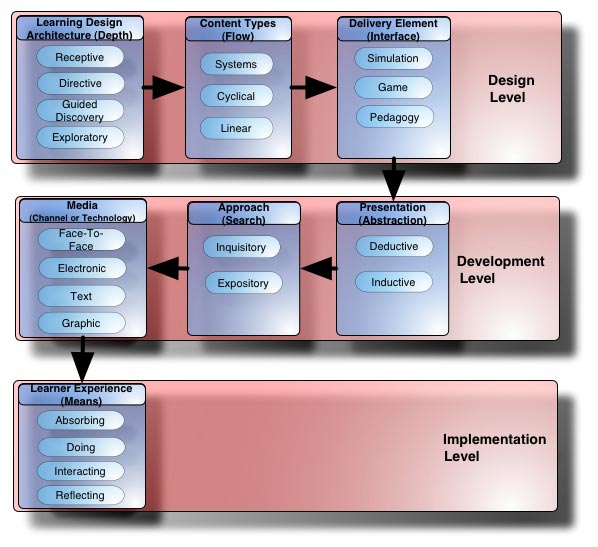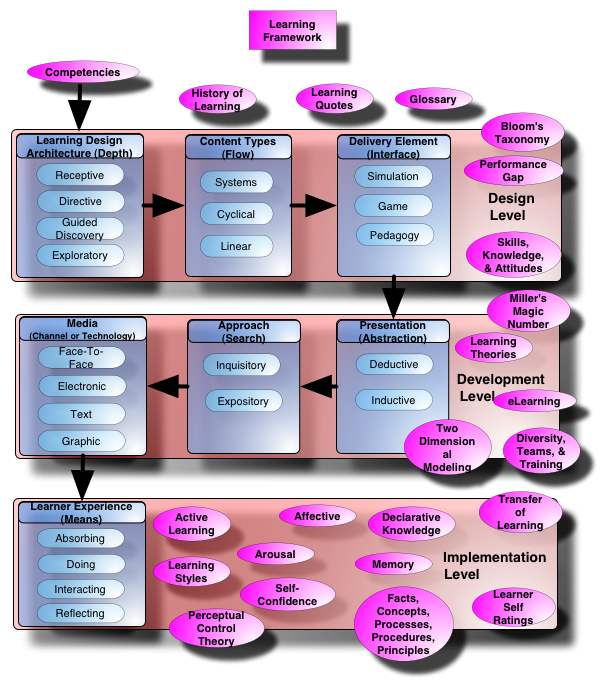Learning and the Environment
In Simulations and the Future of Learning: An Innovative (and Perhaps Revolutionary) Approach to e-Learning, Clark Aldrich writes that It is not the normal how-to textbook, but rather a true story about building a leadership simulation. It is quite interesting and highly recommended. In the book, Aldrich discusses three types of contents: linear, cyclical, and open-ended. He recently refined and elaborated on this concept with a paper titled Six Criteria of an Educational Simulation.
In the paper, Aldrich writes that there are six criteria, divided into two groups, that compose a learning environment:
Content Types:
Delivery Elements:
Content Types
Content types describe directional flow of the content. Linear content is presented with one event or step following the next. It is perhaps the most widely used type of all as it provides a solid background (and it is simple to build). Cyclical content addresses “muscle memory,” such as learning to hit a tennis ball, pedal a bike, play the piano, or type. While linear content is more or less academic, in that it helps to describe a task; cyclical content goes beyond this to learning a skill. System content deals with complex relationships.
For example, when learning to drive:
- Linear: Starting the car by fastening seat belt, inserting and turning the key, putting it in drive, etc.
- Cyclical: Starting and stopping. Telling someone to make the car move by stepping on the gas and make it stop by pressing the brake pedal is linear, but having them actually learn by doing is cyclical in that it requires muscle memory.
- System: Driving the car under real conditions so that you have the various interactions of law, other drivers (both bad and good), weather conditions, maneuvering the car, and navigating.
Delivery Elements
Normally, the most successful educational experiences are built on three delivery elements: simulation, game, and pedagogical. Pedagogical or didactic elements ensure that the learner's time is productive. Game interactions provide familiar and entertaining interactions. While simulation elements provide reality.
Going back to the driving example:
- Pedagogical: testing the learners on rules of the road
- Game: Using an arcade driving game to teach the learners how to steer
- Simulation: Driving a car in a mock-up or simulated driving course
Learning Methodology: Providing a Learning Environment
The two concepts of delivery elements and content types are quite interesting in that they give us a wider platform for building learning programs. Listed below are five other considerations (they are covered in more detail at ISD at Warp Speed).
There are four learning design architectures:
- Receptive: absorbing information
- Directive: frequent responses coupled with feedback (behavioral roots)
- Guided Discovery: active constructive process mediated by problem solving
- Exploratory: finding and processing information
In turn, the four architectures help us to learn by various experiences:
- Absorbing (read, hear, feel)
- Doing (activity)
- Interacting (socialize)
- Reflecting
There are two main methods for presenting instructional content:
- Deductive: having the learners work from general information to examples
- Inductive:giving the learners examples to abstract
In addition, there are two main approaches for helping the learners to learn:
- Inquisitory: having the learners find examples or general information
- Expository: explicitly giving examples and general information
When we put all the above"design considerations together, we have to develop (build) it for a type of media, such as web, classroom, text, combination (blended), or more simply, a Learning Framework. Thus, when building a learning program, it helps to think of a wider framework than simply shoveling the content (subject matter) to the learners. That is, one has to start thinking of the context that will support it:
Learning Framework

Informal/Formal Learning — Social Learning & Media — Blended Learning
- Learning Design Architecture: determines the "depth" of the learning
- Content Types determines directional "flow"
- Delivery Elements: determines the "interface"
- Media: defines "how" the program will be delivered (channel)
- Approach: Defines how the learner will "search" through the content
- Presentation: defines the "starting point" or abstraction
- Learner Experience: determines the "means" by which the student learns
References
Aldrich, Clark (2004). Simulations and the Future of Learning. San Francisco: Pfeiffer
Going the "Simulation Way": Q&A with Clark Aldrich
Simulations and the Learning Revolution: An Interview with Clark Aldrich


